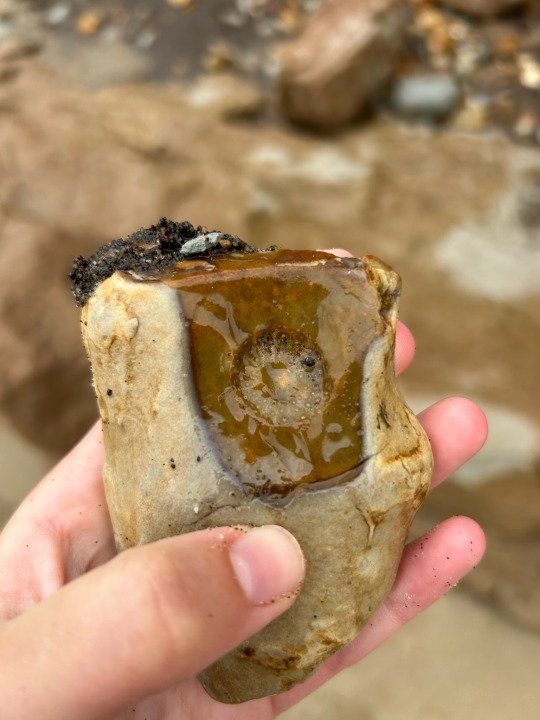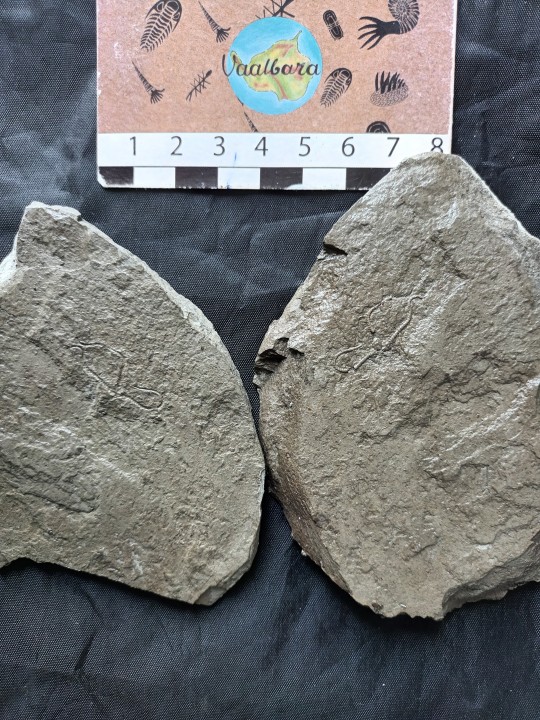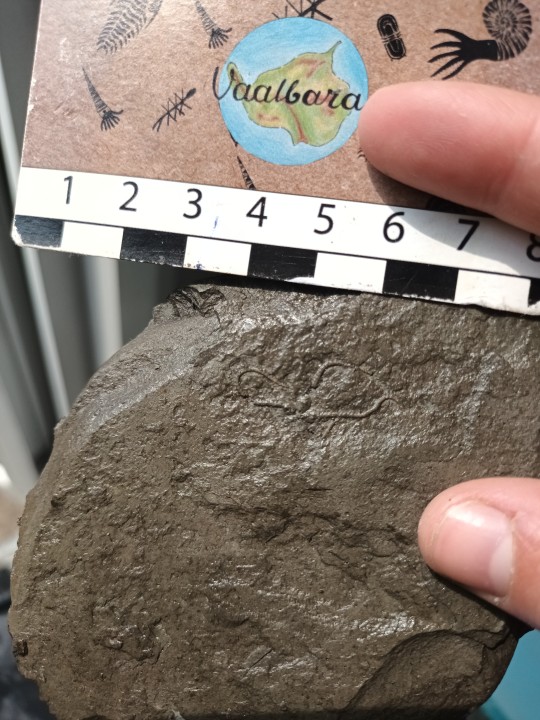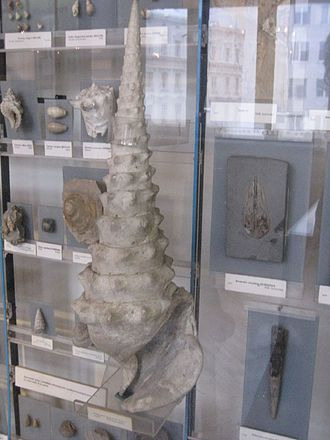#echinoderm fossil
Explore tagged Tumblr posts
Photo

Rare Apiocrinites elegans Fossil Crinoid Calyx – Bajocian, Jurassic – Langrune-sur-Mer, France – Certified Genuine Marine Fossil
This listing offers a beautiful and rare fossil calyx of Apiocrinites elegans, a species of crinoid (commonly known as sea lilies), discovered in the Bajocian-aged rocks of Langrune-sur-Mer, France, part of the Middle Jurassic period, approximately 170 million years ago.
Crinoids are marine echinoderms, related to starfish and sea urchins, that flourished throughout the Palaeozoic and Mesozoic eras. Apiocrinites elegans is especially well-known for its elegant, vase-shaped calyx and finely detailed plating structure, preserved in limestone or marl from shallow, warm Jurassic seas.
This species belonged to the subclass Camerata and was typically attached to the seafloor via a stalk, with feathery arms that extended from the calyx to filter plankton from the water. Fossil crinoids like Apiocrinites provide important information about ancient marine ecosystems and are a staple in palaeontological collections due to their beauty and evolutionary significance.
The Bajocian stage of the Jurassic marks a time of significant diversification in marine life. The fossil-rich formations around Langrune-sur-Mer are renowned for yielding well-preserved invertebrates, particularly crinoids.
This specimen is an outstanding representative of Jurassic echinoderm fauna, offering both educational and display value.
Item Details:
Genus/Species: Apiocrinites elegans
Type: Crinoid Calyx (Sea Lily)
Geological Age: Middle Jurassic – Bajocian (~170 million years ago)
Formation: Marine limestone beds
Location Found: Langrune-sur-Mer, France
Scale Reference: Scale rule / cube = 1cm (please see photo for exact size)
Certificate of Authenticity: Included
ACTUAL AS SEEN:
The image shows the exact specimen you will receive. This fossil has been carefully chosen and professionally photographed. Measurements are as accurate as possible, but minor variations may occur due to lighting, natural shape, or device display. Once this item is sold, the listing will refresh with a new specimen and image.
100% Genuine Fossil – Professionally Selected – Certificate of Authenticity Included
#Apiocrinites elegans#fossil crinoid#crinoid calyx#Jurassic fossil#Bajocian fossil#Langrune-sur-Mer fossil#French marine fossil#sea lily fossil#echinoderm fossil#marine invertebrate fossil#palaeontology specimen#fossil collection#fossil echinoderm#certified fossil#fossil gift
0 notes
Text
Fossil Friday: Sea Stars

The oldest star fish fossils are dated back to the middle Ordovician of Alabama.

This is the Alabamian specimen, Schuchertia, a carnivorous sea star. It is approximately 450 million years old.
Starfish are part of an invertebrate group known as the echinoderms which means "hedgehog skin". Echinoderms include :

Star fish specifically belong to the class Asteroidea (means like stars). Their fossil record is sparse because they tend to break apart before fossilization. Most of the time we only find the ossicles, small calcareous bits embedded in the dermis.

The larvae of echinoderms have bilateral symmetry, but during metamorphosis this is replaced with radial symmetry, typically pentameric.

Adult echinoderms are characterized by having a water vascular system with external tube feet


and a calcareous endoskeleton consisting of ossicles connected by a mesh of collagen fibers. Starfish are included in the subphylum Asterozoa, the characteristics of which include a flattened, star-shaped body as adults consisting of a central disc and multiple radiating arms.
There are over 1900 living species in seven orders and an estimated 1200 extinct species (again, hard to know since they disintegrate after death).

Brisingida: Species in this order have a small, inflexible disc and 6–20 long, thin arms, which they use for suspension feeding. They have a single series of marginal plates, a fused ring of disc plates, a reduced number of aboral plates, crossed pedicellariae, and several series of long spines on the arms. They live almost exclusively in deep-sea habitats, although a few live in shallow waters in the Antarctic.

Forcipulatida: Species in this order have distinctive pedicellariae, consisting of a short stalk with three skeletal ossicles. They tend to have robust bodies and have tube feet with flat-tipped suckers usually arranged in four rows.

Notomyotida: These starfish are deep-sea dwelling and have particularly flexible arms. The inner dorso-lateral surfaces of the arms contain characteristic longitudinal muscle bands.

Paxillosida: This is a primitive order and members do not extrude their stomach when feeding, lack an anus and have no suckers on their tube feet. Perhaps some of our extinct friends belong in this order?

Spinulosida: Most species in this order lack pedicellariae and all have a delicate skeletal arrangement with small or no marginal plates on the disc and arms. They have numerous groups of short spines on the aboral surface.

Valvatida: Most species in this order have five arms and two rows of tube feet with suckers. There are conspicuous marginal plates on the arms and disc.

Velatida: This order of starfish consists mostly of deep-sea and other cold-water starfish often with a global distribution. The shape is pentagonal or star-shaped with five to fifteen arms. They mostly have poorly developed skeletons with papulae widely distributed on the aboral surface and often spiny pedicellariae.
Fun fact about starfish and other echinoderms; they are actually more closely related to us than to other invertebrates. Wild right?

Maybe one day we'll be able to learn more about fossil starfish. Until then, tune in Monday to learn about the Hirnantian glaciation. Have a good weekend and fossilize you later!
23 notes
·
View notes
Text

Fossil Crinoid Plate Taxocrinus Cribanocrinus Indiana Edwardsville Formation Mississippian Age Echinoderm
#echinoderms#echinoderm#fossil#fossils#crinoid#crinoids#fossil Crinoid#taxocrinus#Indiana#prehistoric#png#transparent#paleontology#paleoblr
8 notes
·
View notes
Text




Fossil hunting visit 2
I got a lot of few new fossils for todays post. Found another location with lot of stones & rubble. With the ok from the owner of his pile/ surrounding field area to search.
It was an fun time to search for rocks this time. Mostly broken upper and top fragments of flint urchins, nice finds to compare with others.
These are quiet big chunks of echinoid.
Two of them, after washing in my hand are mostly intact ones.
It‘s a shame all years thats pieces like this got lost and destroyed from the shipping for fundamental use or industrial constructions or street underground.
Oh there is no blood, it is the wet red marking of the inner flint core.
20.03.2024 post reupload
#fossils#echinoderm#echinoids#fossil collecting#geology#fossil hunting#fossils 2024#flint fossil#fossils in germany
22 notes
·
View notes
Text
#2496 - Fellaster zelandiae - Snapper Biscuit

AKA Cake Urchin.
Fellaster zelandiae is and was endemic to Aotearoa - the other species, incisa, was found in Australian waters.
Sand dollars (also known as sea cookies, sea biscuits, or pansy shells) are flat, burrowing sea urchins in the order Clypeasteroida. They first evolved from other irregular echinoids in the Jurassic, and live in temperate and tropical oceans worldwide, using their velvety spines to burrow through soft sediments, feeding on algae and organic matter. Some species prop themselves up sideways to feed on passing plankton.
Unlike most echinoids, sand dollars have developed a secondarily bilateral symmetry, including an anus towards the rear of the animal instead of centrally on top, as part of their evolution into burrowing animals.
Some sand dollar larvae have been shown to clone themselves if they detect the mucus of predatory fish in the water.
Whanganui Regional Museum, New Zealand
#Clypeasteridae#sand dollar#fellaster#new zealand fossil#fossil echinoderm#whanganui#snapper biscuit#cake urchin
14 notes
·
View notes
Text




The new wave of echinodem. Some in ovale, brown with little remicent of their distant shell pattern. Found great ones in good condition.
The two orange broken parts in orange flint.
Some have clear pattern, others are chunky.
And the other three in gray, with outstanding intact one in darker gray.
All are good example to shown of the varity to finding and for id.
#fossils#geology#fossil hunt#echinoids#echinoid#echinoderm#fossils in germany#fossils 2024#fossil collecting#fossil friday
24 notes
·
View notes
Text

Regular echinoid fossil I found today. It is from the Vectis formation and is around 80 million years old.
See the perfect five-fold symmetry as opposed to the irregular echinoid I posted yesterday.
#fossils#echinoderm#echinoid#palaeontology#cretaceous period#late cretaceous#special interest#actually autistic
9 notes
·
View notes
Text



Brittle star from the Boulonnais.
These little guys are family of the starfish and are actually kind of rare to find in a fossilized state, because of their soft bodies
#fossil#fossils#boulonnais#fossil hunting#jurassic#palaeoblr#geology#paleontology#paleoblr#brittle stars#echinoderm
44 notes
·
View notes
Text

#ThinsectionThursday and an early #FossilFriday A section through 2 crinoid ossicles from the earliest Jurassic #Redcar Mudstone from Redcar Beach, UK. You can see the joint between ossicles and the stereom texture quite nicely. Brown is OM, black is pyrite.
Microscope photo of a crinoid stem showing it is made from light grey calcite with a bobbly texture called stereom. The plates of the stem are connected via a curving zig zag where rounded ridges on one plate lock into the corresponding grooves of another plate. the upper right of the picture is taken up by light brown organic matter and tiny black squares of pyrite.
#geology#geologyjohnson#palaeontology#jurassic#fossil#fossilfriday#paleontology#crinoid#echinoderm#thinsectionthursday
4 notes
·
View notes
Text
Your Ultimate Guide to Collecting Carcharodontosaurus Fossils

Carcharodontosaurus fossils have become highly treasured among fossil collectors. From razor-sharp teeth to towering vertebrae, fossils belonging to these giant predators provide a peek into an era when carcharodontosaurs walked the Cretaceous landscapes of Africa. In this guide we’ll dive deep into the details of this giant carnivorous dinosaur so you have a better understanding about these beautiful creatures from the past. Read more: https://fossilageminerals.hashnode.dev/your-ultimate-guide-to-collecting-carcharodontosaurus-fossils
0 notes
Text
Round 3 - Chondrichthyes - Heterodontiformes




(Sources - 1, 2, 3, 4)
While several extinct genera of Heterodontiformes are known from the Jurassic, today only one genus, Heterodontus, the “Bullhead Sharks” remains. Ten living species of bullhead shark have been described.
Bullhead sharks are relatively small, with the largest species reaching just 1.65 metres (5.5 ft) in maximum length. They have tapered bodies, with blunt, proportionally large heads, relatively small mouths, pig-like snouts, and pronounced ridges above their eyes. They have two large dorsal fins, the first larger than the second, and an anal fin. Both dorsal fins have a rigid spine at the front of each fin which is used for defense. Bullhead Sharks are bottom feeders in tropical and subtropical waters. They have cusped grasping teeth at the front of the mouth, and flattened teeth at the back of the mouth. They use the flattened teeth at the back of their mouth to crush hard-shelled prey like bivalves, crustaceans, and sea urchins, and the grasping teeth on soft-bodied prey like worms, anemones, and octopuses. They hunt at night by "walking" along the sea floor with alternating motions of their pectoral and pelvic fins.
Bullhead shark egg cases are shaped like an auger, with two spiral flanges. This allows the egg cases to become wedged in the crevices of rocky sea floors, where the eggs are protected from predators; however, some bullhead sharks deposit their eggs on sponges or seaweed. Due to their spiral shape, each egg case requires several hours to rotate out of the mother shark's cloaca (Oof). She usually lays two at a time. The eggs typically hatch after 7 to 12 months, depending on the species. The pups will usually reach over 14 cm in length by the time they leave the egg case.
The Heterodontiforms appear in the fossil record in the Early Jurassic, with modern forms appearing in the Late Jurassic. Despite the very ancient origins of the genus, phylogenetic evidence indicates that all living species in the genus arose from a single common ancestor that survived the K-Pg extinction.

Propaganda under the cut:
Female Japanese Bullhead Sharks (Heterodontus japonicus) are known to deposit their eggs in communal nests, with as many as 15 eggs left in the same nest.
Horn Sharks (Heterodontus francisci) (image 2) have relatively small territories they hunt in at night, returning to the same “house” during the day. They may remain faithful to the same territory for over a decade. Now that’s a homebody.
Horn Sharks are queued by light rather than by an internal clock. In laboratory settings, they will become active as soon as lights are turned off. If they are in the middle of something when the lights are turned on, they may stop swimming and sink to the bottom. In one experiment where the sharks were kept in darkness, they remained continuously active for 11 days before slowing from fatigue. (☹️)
The Horn Shark generates the highest known bite force relative to its size of any shark, which it uses to crack into mollusks, echinoderms, and crustaceans. One study found the average bite force for this species in the wild to be 95 N with a maximum of 135 N, while under experimental conditions sharks could be induced to bite with over 200 N of force.
Female Horn Sharks in the wild pick up their egg cases in their mouths and wedge them into crevices to keep them safe.
In July 2018, three people were arrested after stealing a juvenile Horn Shark from the San Antonio Aquarium. The shark was scooped out of its tank and smuggled out of the aquarium in a stroller, wrapped in a wet blanket. It was thankfully returned unharmed two days later.
The Crested Bullhead Shark (Heterodontus galeatus) (image 4) produces spiral-shaped egg capsules that are secured to seaweed or sponges with long tendrils.
The Crested Bullhead Shark is a major predator of the eggs of the Port Jackson Shark! Individual sharks have been observed taking the egg capsules in their mouths and chewing on the tough casing, rupturing it and allowing the yolk to be sucked out, or simply swallowing the capsules whole.
The Port Jackson Shark (Heterodontus portusjacksoni) (image 1) is a migratory species, traveling south in the summer and returning north to breed in the winter. Males tend to arrive to the breeding grounds first with the females arriving later and staying later, perhaps as a means to reduce egg predation upon their newly laid eggs.
While juvenile Port Jackson Sharks are not particularly social, adults are often seen resting in caves in groups, and prefer to associate with specific sharks based on sex and size. In lab settings, these sharks were shown to have unique personality traits and preferences, can be trained, can count, and can learn by watching other sharks.
66 notes
·
View notes
Photo

RARE Geocoma carinata Starfish Fossil – Ordovician Marine Fossil from Draa Valley, Morocco – w/ COA
Add an exceptionally rare and scientifically significant specimen to your collection with this Geocoma carinata Starfish Fossil, discovered in the fossil-rich marine layers of the Draa Valley, Morocco. Dating to the Ordovician period—over 450 million years ago—this beautifully preserved fossil represents one of the earliest echinoderm species, offering a fascinating glimpse into ancient marine ecosystems.
Geocoma carinata is a rare and extinct species of true starfish belonging to the class Asteroidea, known for its five-rayed symmetry and flattened body with tapering arms. Its preservation in fine-grained marine sediment allows detailed observation of its central disc and radiating arms, making it a scientifically valuable and visually striking addition to any fossil collection.
The Draa Valley in Morocco is one of the most significant fossil sites in North Africa, particularly for Ordovician marine fauna. The region’s well-laminated sedimentary rock layers allow for exceptional fossil preservation, capturing delicate features of invertebrate species that are rarely seen elsewhere.
This is a carefully selected, one-of-a-kind specimen, and the exact fossil shown in the listing photos is the one you will receive. A 1cm scale cube or rule squares is included in the images to provide accurate sizing—please refer to the photos for full dimensions.
Each fossil is 100% genuine and comes with a Certificate of Authenticity, verifying its identity and provenance.
Why Choose This Fossil? ✔️ RARE Geocoma carinata Starfish Fossil from Draa Valley, Morocco
✔️ Ordovician Period – Over 450 Million Years Old
✔️ Exceptional Preservation of Ancient Echinoderm Anatomy
✔️ Highly Collectible and Scientifically Valuable
✔️ 100% Genuine with Certificate of Authenticity
✔️ Exact Fossil Shown – No Substitutes
✔️ Fast & Secure Shipping
Own a true rarity from the depths of Earth’s ancient oceans—order this authentic Geocoma carinata Starfish Fossil today!
#Geocoma carinata#Starfish Fossil#Rare Fossil Starfish#Ordovician Fossil#Draa Valley Fossil#Morocco Fossils#Echinoderm Fossil#Paleozoic Fossil#Marine Fossil#Fossil Starfish Morocco#Natural History Fossil#Geological Specimen#Genuine Fossil#Ancient Sea Life#Fossil Plate#Fossil Slab#Certified Fossil#Fossil Display Piece#Collector Fossil
1 note
·
View note
Text
March Madness Round 2 Bracket 1Happy St. Patrick's Day to all my fellow Irishman (okay, so I only have 1/4 Irish blood but who's counting?).
Today we get to see who won the first two brackets of round one and are now competing against each other. The first competitor is Campanile giganteum! In a landslide victory against Platyceramus (114 vs 75) the giant snail gets to move on! It is found in the Paris Basin in France and lived during the Eocene Epoch 56-33.9 Ma.

And it is going up against the giant crinoid Seirocrinus subangularis which beat out Endoceras by a mere 7 points. Seirocrinus is found in Jurassic rocks in Germany.

#paleontology#fossils#science#science education#march madness#science side of tumblr#crinoid#gastropods#molluscs#echinoderm
13 notes
·
View notes
Text

Utah Fossil Star Crinoid Pentacrinus Jurassic Age Echinoderm
#crinoids#crinoid star fossil#crinoid#Crinoid fossil#fossil#fossils#fossilized#png#transparent#paleontology#paleoblr
372 notes
·
View notes
Text
Bowls full of tiny nice round echinoids.


The mug now full with smaller, round beutiful echinoids of Echinocorys & more galerites vulgaris etc which were previously on the metal bowl.
They have the sizes of different coins. 🪙
I think some of them would be nice to stored and looking into them in an glass jar.
More zoomed pics will coming soon. 🪨
#fossil collecting#fossils#fossils in germany#geology#flint fossil#echinoids#echinocorys#galerites vulgaris#echinoderm#collecting rocks#galerites & echinocorys#🪨#fossils from others#sea urchin#out of the box 📦#fossils 2025
2 notes
·
View notes
Text

Nicknamed the "Y animal" or "wye", Escumasia roryi is an enigmatic fossil organism known from the Late Carboniferous Mazon Creek fossil beds in Illinois, USA, dating to about 308 million years ago.
Growing up to around 15cm tall (~6") this strange soft-bodied creature was Y-shaped, with two slender "arms" on each side of an apparent mouth opening, a flattened sac-like body with another opening on one side, and a long stalk ending in an attachment disc. Some specimens have uneven arm lengths, which may indicate damage from predation.
Being only known from the exceptional preservation conditions of Mazon Creek, and with nothing else quite like it in the known fossil record, Escumasia's evolutionary relationships are still a mystery. It's been tentatively linked to cnidarians – but this doesn't really fit based on its anatomy, and little further study has been done on it since its discovery in the 1970s.
It was probably a filter feeder, living attached to the seafloor and capturing suspended organic material or small planktonic prey with its arms. The environment it inhabited was a shallow tropical marine bay, located close to the equator at the time, near a large river delta that would have made the surrounding waters rather brackish. This ecosystem was dominated by cnidarians, particularly the anemone Essexella, along with various arthropods, lobopodians, polychaete worms, molluscs, echinoderms, fish, lampreys, hagfish, and other difficult-to-classify weirdos like the famous "Tully monster" Tullimonstrum.
———
NixIllustration.com | Tumblr | Patreon
References:
Clements, Thomas, Mark Purnell, and Sarah Gabbott. "The Mazon Creek Lagerstätte: a diverse late Paleozoic ecosystem entombed within siderite concretions." Journal of the Geological Society 176.1 (2019): 1-11. https://doi.org/10.1144/jgs2018-088
Nitecki, Matthew H., and Alan Solem. "A problematic organism from the Mazon Creek (Pennsylvanian) of Illinois." Journal of Paleontology (1973): 903-907. https://www.jstor.org/stable/1303070
Wikipedia contributors. “Mazon Creek fossil beds.” Wikipedia, 10 May 2024, https://en.wikipedia.org/wiki/Mazon_Creek_fossil_beds
#science illustration#paleontology#paleoart#palaeoblr#escumasia#incertae sedis#problematica#animalia#art#y animal#wye#actual ancient aliens
190 notes
·
View notes